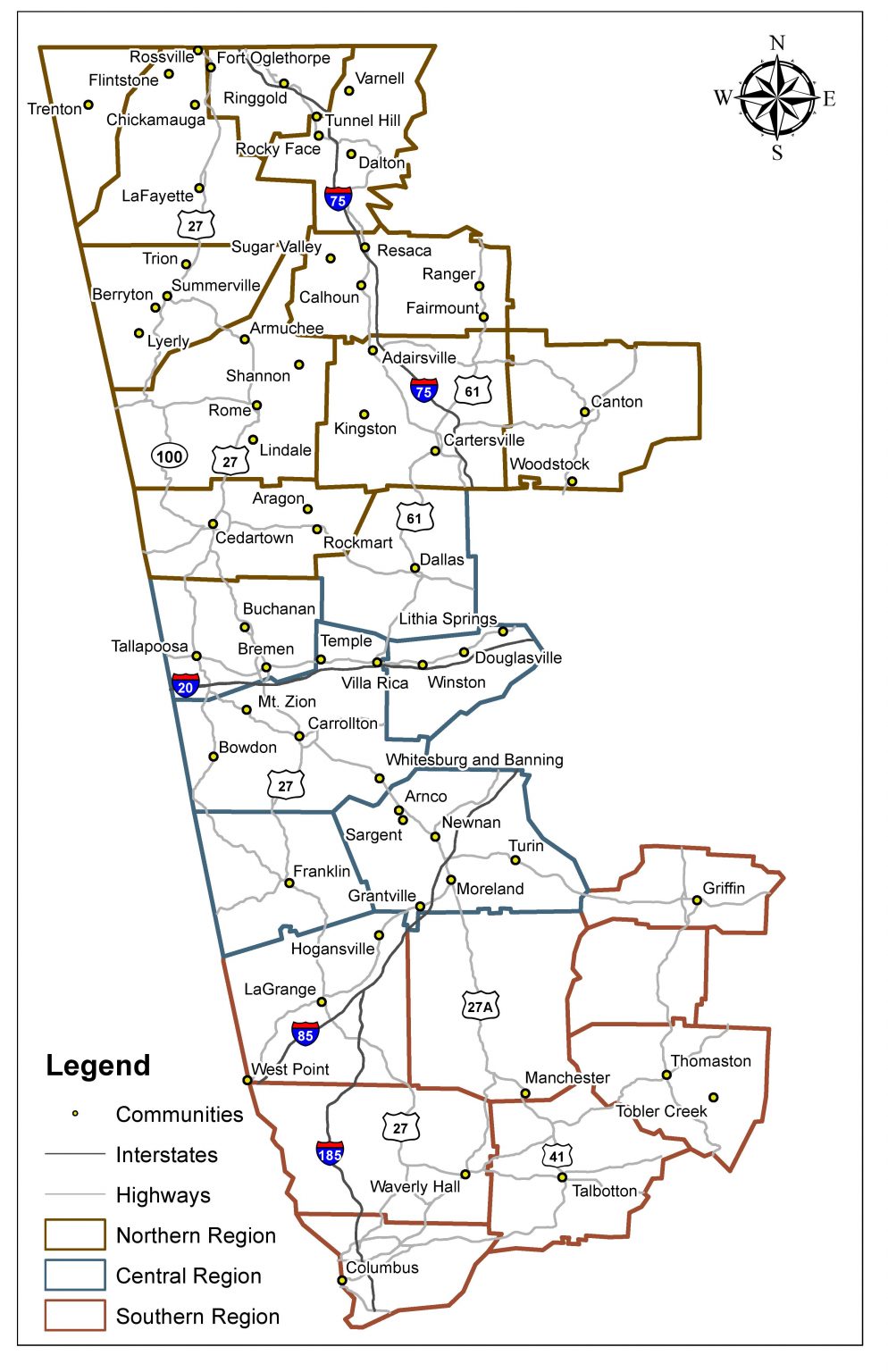Threads of the Past
Exploring Fullerville’s Textile History

Sites to See Along the Trail
[expand title=”1. “Take me out to the Ballgame:” The Fullerville Ball Field”]Start your journey around Fullerville at the ball fields. America’s favorite pastime helped Fullerville’s mill workers let off steam and relax after grinding shifts on the mill floor. Mill companies formed teams and their players competed against those from other mills from across the region. Mill teams were a source of pride and entertainment. Fullerville’s workers celebrated their team’s athletic achievements, especially when they defeated local rival Mandeville Mills in Carrollton. [/expand]
[expand title=”2. Ain’t Misbehavin’! The Fullerville Jail”]Work at the mill was hard. The work days were long and the pay was typically low. As in most towns, violence and unlawful behavior occasionally occurred. This one-room building was used as a holding cell, sometimes called the “drunk tank” by locals. Similar jail buildings can be found in many small towns throughout the United States.[/expand]
[expand title=”3. Getting the Goods to Market: The Railroad Spur”]Look for the remnants of an old switch track railroad spur between the cotton and hosiery mills. This portion of the railroad is no longer operational, but you can still see evidence of its path between the mill and the old jail. The track was originally built to connect an old sulphur mine in northern Carroll County to the Georgia Pacific Railroad, (which still runs along U.S. Highway 78 in downtown Villa Rica). This spur line allowed the Fullerville mills to connect to the main railroad line running through Villa Rica and thus ship and receive goods to and from distant locations.[/expand]
[expand title=”4. Spinning Cotton: The Villa Rica Cotton Mill”]In 1901, Judson T. Fuller settled in Villa Rica and purchased 60 acres of land five miles north of the city. Five years later, he opened the Villa Rica Cotton Mill here to process raw cotton into yarn. Openers and pickers opened giant burlap bales of cotton and removed the debris before sending it to other employees called carders, spinners, and spoolers for processing it into yarn. Sometimes entire families worked in the mill to earn enough money to pay for their housing, food, and other necessities. Even with everyone pitching in, most families still struggled to make ends meet. t[/expand]
[expand title=”5. Where is the Water? Water Towers, Outhouses, and Wells”]Cotton mills were a fire hazard, as the raw cotton was extremely flammable. Like most rural southern communities, Fullerville did not have running water, so the company built this water tower to provide a water supply and protect the mill against fire.[/expand]
[expand title=”6. Readin’, Writin’, and ‘Rithmetic: The Mill School”]In 1912, the mill company opened a school for the children of its workers. Most mills provided a school for residents in their mill villages, even though many of the children also worked in mills. Prior to the Great Depression, mills throughout west Georgia frequently employed child workers under the age of 14 so many children only received a few years of formal education. Mill owners and Georgia leaders alike believed that mill children only needed enough schooling to teach them to read and do basic addition and subtraction. [/expand]
[expand title=”7. Knitting Socks: The Villa Rica Hosiery Mill”]This hosiery mill was the Fuller family’s most profitable enterprise. Established in 1911, the company produced seamless socks of cotton. At this time, hosiery mills produced unisex socks of cotton, silk, and rayon with a ribbed top that could be worn by men, women, children, and infants. In the early years, the majority of the company employees were women.
In 1980, Pam Bruce, daughter of company president E.T. Doyal, acquired this mill building and operated the Villa Rica Knitters, which produced a variety of knitted items including scarves, hats, and slippers, but this company has also closed.
[/expand]
[expand title=”8. Serving the Community: The Fullerville Baptist Church”]For several generations, Fullerville’s churches, including the Fullerville Baptist Church, have served as the focal point of the community’s spiritual life. Known for its homecoming activities and traditional services, Fullerville Baptist Church has held services here since 1933. [/expand]
Be on the lookout for these different mill houses throughout Fullerville:
[expand title=”1. Pyramidal Cottage “]The Pyramidal Cottage is one of the first house types built near the cotton mill in the early 1900s, and there are 15 of these remaining. They are one-story, wood-frame homes with pyramidal roofs, a central chimney, and a full front porch. All of these duplexes had two front doors, each leading into a two-room deep unit. Some have been enlarged over the last 100 years. See if you can spot some of the remaining outhouses.[/expand]
[expand title=”2. Saddlebag House Type”]There are seven examples of the Saddlebag house type scattered throughout the village. These houses feature a one-room deep plan with a gable roof, central chimney, full front porch, and two front doors. Many also have a kitchen ell.[/expand]
[expand title=”3. Double Shotgun House”]The Double Shotgun plan is particularly common around the hosiery mill. There are at least 18 examples of these found along Rockmart Road in front of the hosiery mill and others on Pate Road. They are one-story, wood-frame structures with the gable end facing the road. As with other mill houses, they have a full front porch and a central chimney. These are also duplexes, with two front doors.[/expand]
Email the Trail at wgtht@westga.edu or call UWG Center for Public History at 678-839-6141 for more information.
